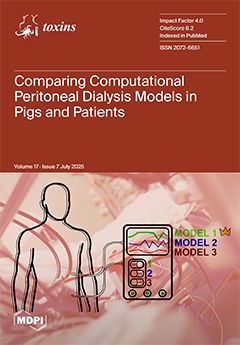In this paper, cultivable actinobacteria were isolated, cultured, and identified from the heavily algal-bloomed waters of Taihu Lake using 16S rRNA gene sequencing. Among the isolates, a single strain exhibiting vigorous cyanocidal activity against
Microcystis aeruginosa FACHB-905 was selected for further investigation. The
[...] Read more.
In this paper, cultivable actinobacteria were isolated, cultured, and identified from the heavily algal-bloomed waters of Taihu Lake using 16S rRNA gene sequencing. Among the isolates, a single strain exhibiting vigorous cyanocidal activity against
Microcystis aeruginosa FACHB-905 was selected for further investigation. The cyanocidal efficacy and underlying mechanisms of this strain, designated TH05, were assessed through using chlorophyll content, cyanobacterial inhibition rate, and cyanobacterial cell morphology measurements. In addition, oxidative stress responses, expression of key functional genes in FACHB-905, and variations in microcystin concentrations were comprehensively evaluated. Cyanobacterial blooms caused by
Microcystis aeruginosa pose serious ecological and public health threats due to the release of microcystins (MCs). In this study, we evaluated the cyanocidal activity and mechanism of a novel actinomycete strain,
Streptomyces sp. TH05. Optimization experiments revealed that a light–dark cycle of 12 h/12 h, temperature of 25 °C, and pH 7 significantly enhanced cyanocidal efficacy. Under these conditions, TH05 achieved an 84.31% inhibition rate after seven days of co-cultivation with
M. aeruginosa. Scanning electron microscopy revealed two distinct cyanocidal modes: direct physical attachment of TH05 mycelia to cyanobacterial cells, causing cell wall disruption, and indirect membrane damage via extracellular bioactive compounds. Biochemical analyses showed increased levels of malondialdehyde (MDA), superoxide dismutase (SOD), and catalase (CAT) during the first five days, peaking at 2.47-, 2.12-, and 1.91-fold higher than control levels, respectively, indicating elevated oxidative stress. Gene expression analysis using
elf-p as a reference showed that TH05 modulated key genes associated with photosynthesis (
PsaB,
PstD1,
PstD2,
RbcL), DNA repair and stress response (
RecA,
FtsH), and microcystin biosynthesis (
McyA,
McyD). All genes were upregulated except for
RbcL, which was downregulated. In parallel, microcystin content peaked at 32.25 ng/L on day 1 and decreased to 16.16 ng/L by day 9, which was significantly lower than that of the control group on day 9 (29.03 ng/L). These findings suggest that strain TH05 exhibits potent and multifaceted cyanocidal activity, underscoring its potential for application in the biological control of cyanobacterial blooms.
Full article






